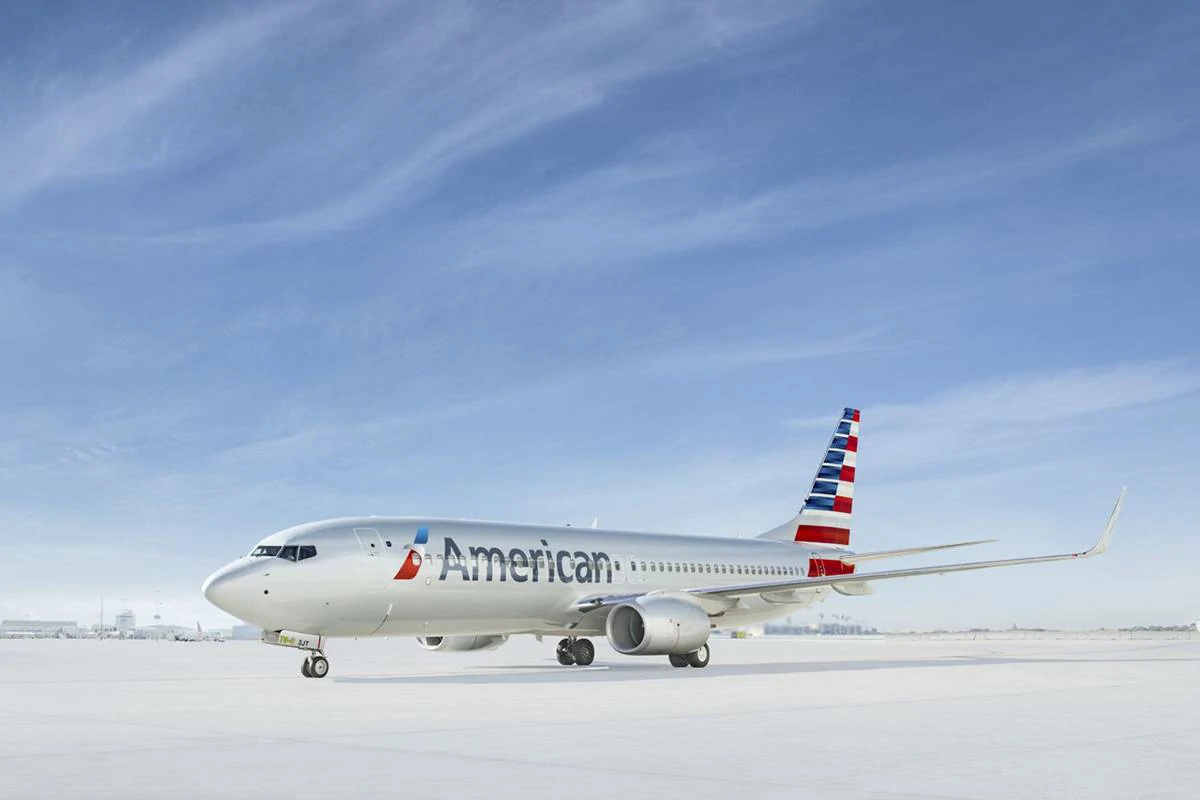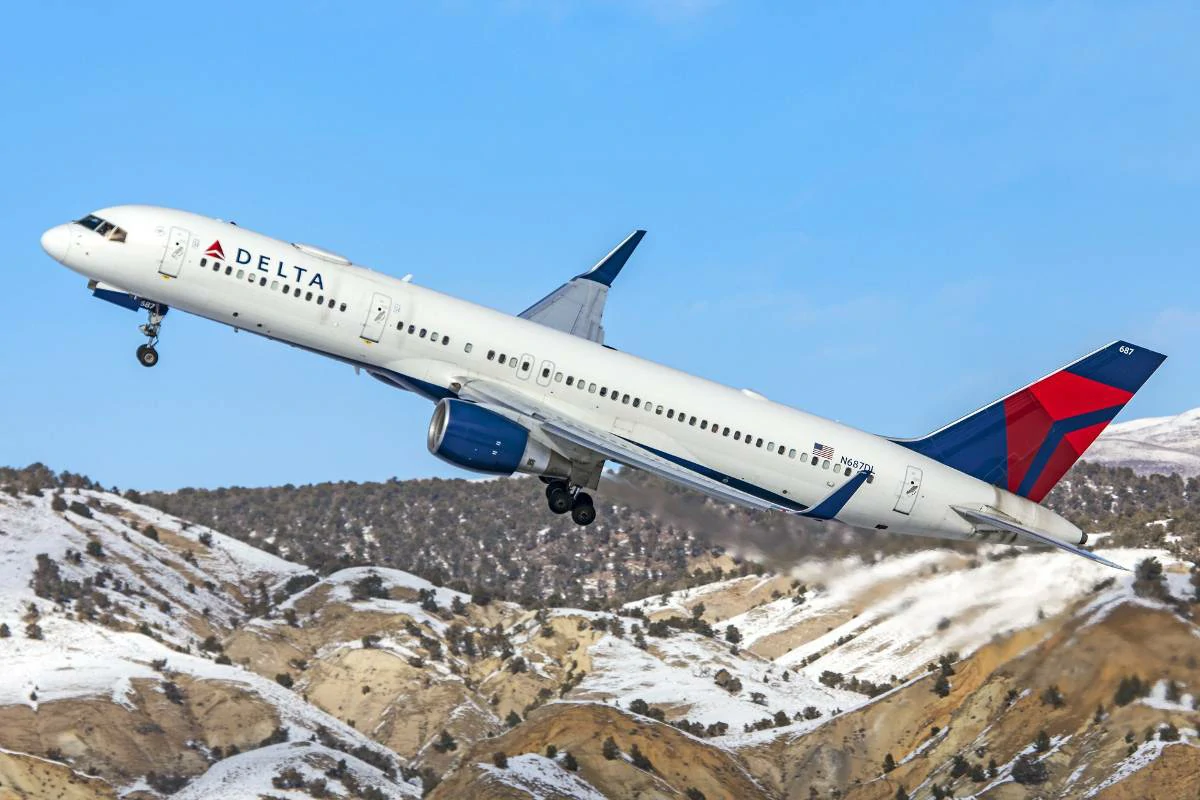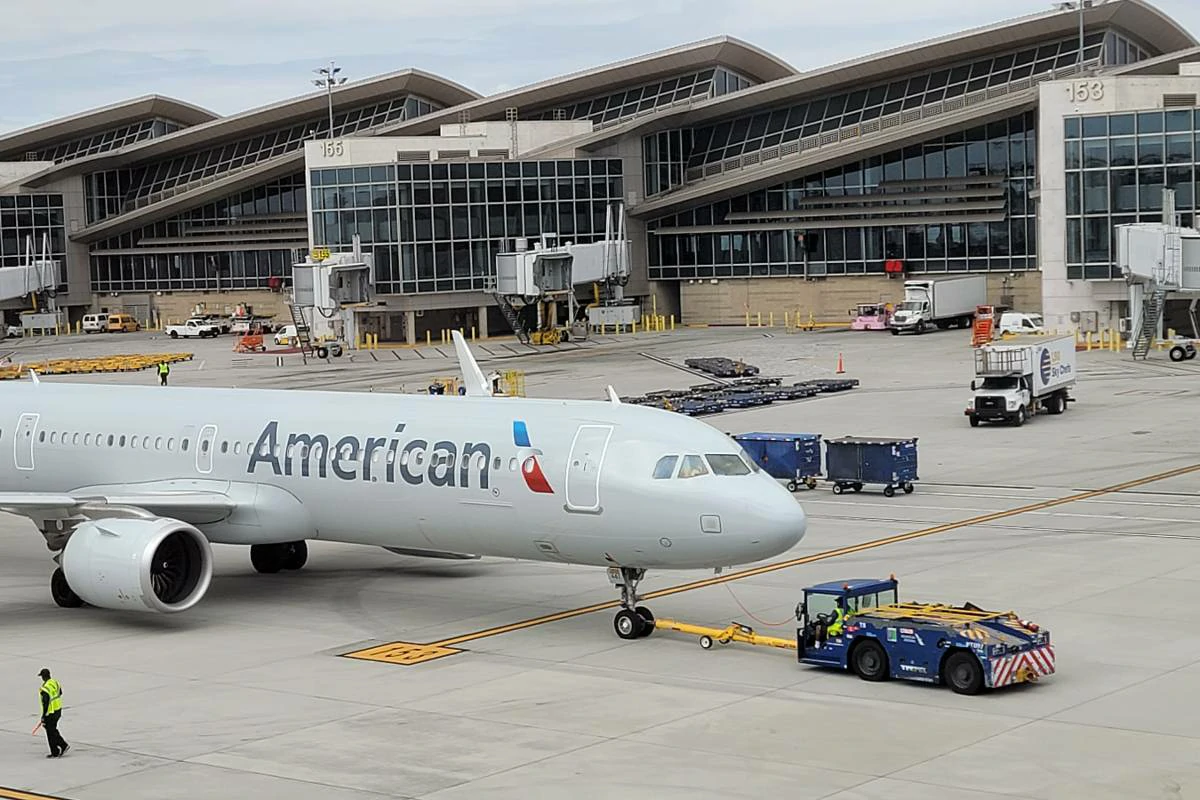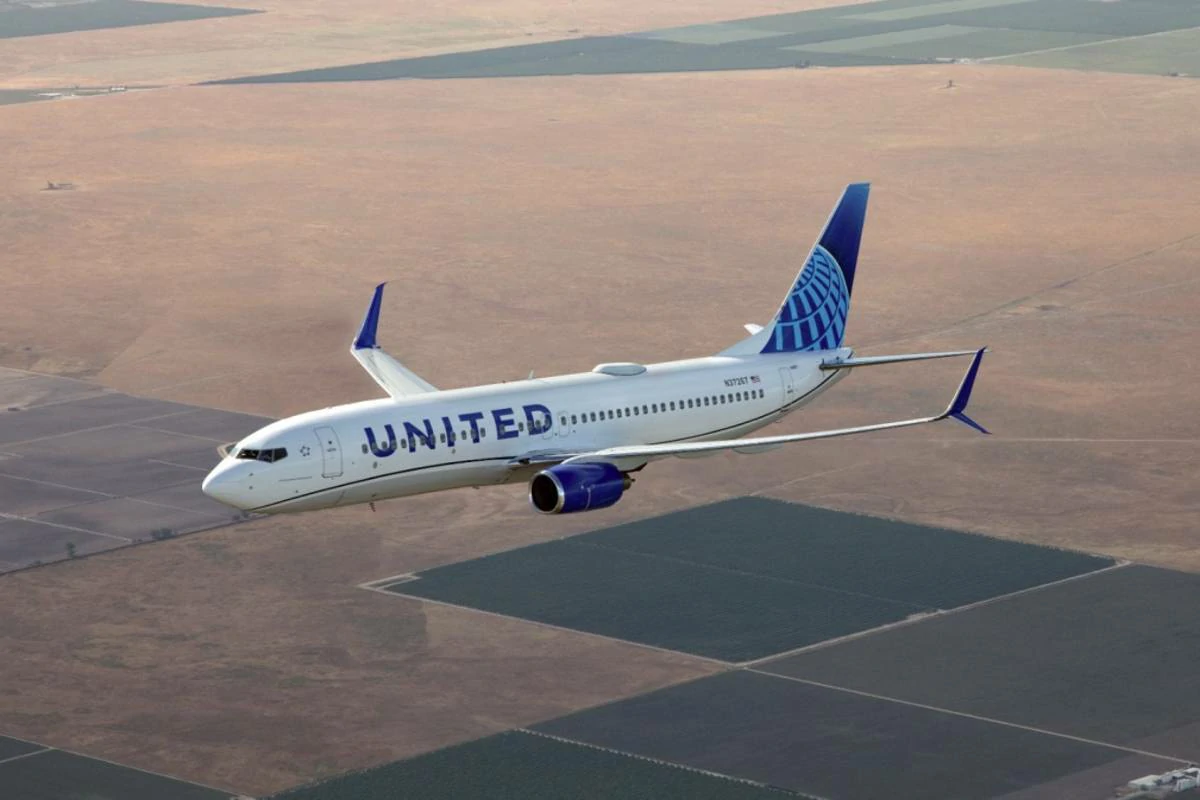How to Fly With a Dog? Answer is – Flying with your dog involves several steps to ensure a safe and comfortable journey for both of you. Choose between cabin and cargo travel based on your dog’s size and airline policies. If flying in the cabin, your dog must fit in a carrier under the seat. Larger dogs typically travel as cargo. Prepare necessary documents like health certificates and vaccination records. Familiarize your dog with the carrier beforehand to reduce anxiety. On the flight day, arrive early, follow airline check-in procedures, and adhere to any specific regulations. Prioritize your dog’s well-being throughout the journey.
Summary
- Flying with your dog involves: choosing between cabin and cargo travel, preparing necessary documents, and ensuring your dog’s comfort and safety.
- Cabin travel: suitable for small dogs that fit in a carrier under the seat.
- Cargo travel: often required for larger dogs and involves specific regulations.
- Essential preparations: include health certificates, vaccination records, and carrier familiarization.
- Airline policies: vary, so research and comply with specific requirements.
- Prioritize your dog’s well-being: throughout the journey to ensure a positive experience.
How to Fly With a Dog?
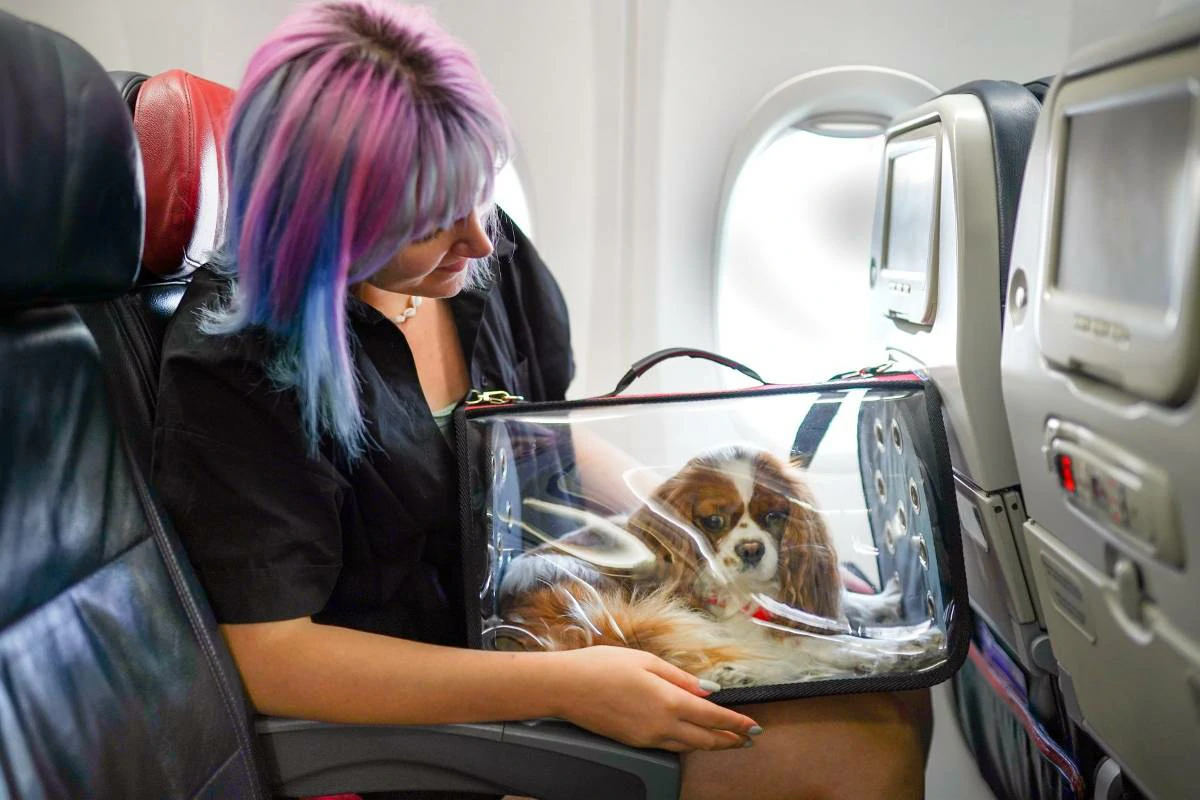
Why Fly with Your Dog?
There are numerous reasons why you might choose to bring your canine companion on your next flight.
Perhaps you’re relocating to a new city or country, embarking on an extended vacation, or simply can’t bear to be separated from your furry friend. Whatever the reason, air travel with your dog is becoming increasingly common and accessible.
According to the U.S. Department of Transportation, approximately 2 million pets fly on commercial airlines in the United States each year.
“Traveling with your pet can be a rewarding experience, strengthening the bond between you and your furry companion,” says Dr. Sarah Miller, a veterinarian specializing in animal behavior at the Animal Medical Center in New York City. “However, it’s crucial to plan meticulously and prioritize your pet’s safety and comfort throughout the journey.”
General Considerations
Before booking your flight, it’s important to consider your dog’s breed, size, age, health, and temperament.
Some breeds, such as brachycephalic (short-nosed) dogs, may face breathing difficulties during air travel, especially in cargo holds.
If your dog is elderly, anxious, or has underlying health conditions, consult your veterinarian to assess their fitness for flying.
“Air travel can be stressful for animals,” warns Dr. Miller. “It’s essential to prepare your pet for the experience by gradually acclimating them to their travel carrier and ensuring they are up-to-date on vaccinations and preventive medications.”
Researching and understanding the airline’s pet policies is crucial. Each airline has specific regulations regarding pet carriers, breed restrictions, health certificates, and fees. Be sure to familiarize yourself with these guidelines well in advance to avoid any surprises at the airport.
“It’s wise to choose an airline with a proven track record of pet safety and well-being,” advises Dr. Miller. “Look for carriers that offer pet-friendly amenities, such as temperature-controlled cargo holds and trained personnel to handle animal passengers.”
Cabin vs. Cargo Travel
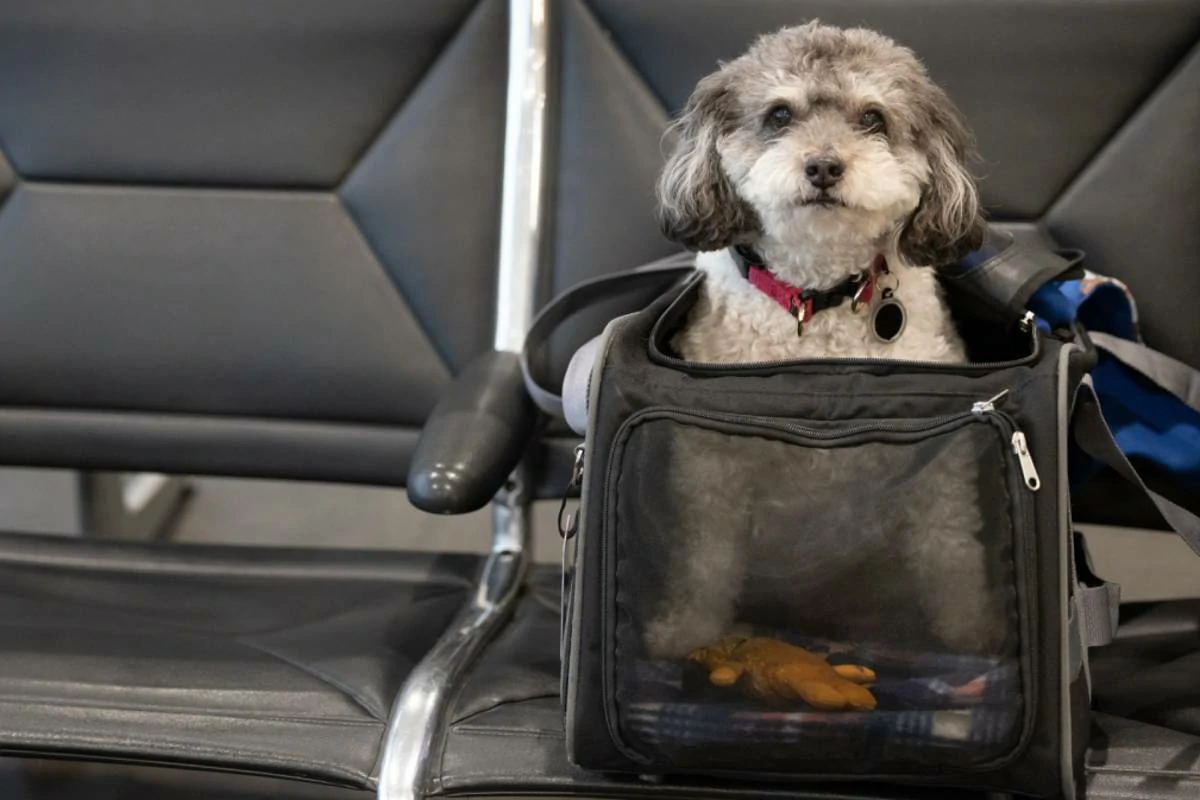
1. Can my dog sit on my lap during a flight?
In most cases, your dog cannot sit on your lap during a flight. Airlines typically require pets to remain in an approved carrier for the duration of the journey. This is to ensure the safety and comfort of all passengers on board.
The International Air Transport Association (IATA), which sets global standards for air travel, specifies that “animals must be properly secured in an appropriate container and placed in an approved location in the cabin.”
However, there are exceptions for service animals. These are dogs specifically trained to perform tasks for individuals with disabilities. Service animals are permitted to accompany their handlers in the cabin without being confined to a carrier, as long as they meet certain requirements.
2. What size dog can fly in the cabin?
The size of a dog allowed to fly in the cabin varies depending on the airline and the specific aircraft. Generally, airlines require pets to fit comfortably in a carrier that can be stowed under the seat in front of you. This means that only small dogs, typically weighing up to 20 pounds (9 kg), can travel in the cabin.
“Most airlines have size restrictions for pets traveling in the cabin,” explains Dr. Emily Parker, a veterinarian specializing in animal travel at the Veterinary Specialty Center in San Diego. “It’s crucial to check the airline’s specific guidelines to ensure your dog’s carrier meets the dimensions and weight requirements.”
Some airlines, like JetBlue and United Airlines, publish detailed information on their websites about pet carrier dimensions and size restrictions. It’s also advisable to contact the airline directly to confirm their pet policy and ask any questions you may have.
If your dog exceeds the size or breed restrictions for cabin travel, they may need to travel as cargo. While cargo travel may seem daunting, airlines have strict regulations in place to ensure the safety and well-being of animals transported in this manner.
“It’s important to understand that cargo travel is different from cabin travel,” says Dr. Parker. “Cargo holds are typically temperature-controlled and pressurized, but it’s still a less comfortable experience for pets than being in the cabin with their owners.”
3. Flying with a large dog vs. small dog: Pros and Cons
| Feature | Flying with a Small Dog | Flying with a Large Dog |
|---|---|---|
| Travel Method | Typically in-cabin (under the seat) | Usually as cargo |
| Airline Restrictions | Fewer restrictions; more airlines allow | More restrictions; fewer airlines allow |
| Cost | Lower fees | Higher fees |
| Comfort | More comfortable for the dog as they can be with the owner | Less comfortable for the dog as they travel alone in the cargo hold |
| Convenience | Easier to manage during travel | Requires more planning and coordination |
| Risk | Lower risk of injury or stress | Higher risk of injury or stress due to handling and environmental factors in the cargo hold |
“The decision to fly with a large or small dog depends on individual circumstances and preferences,” says Dr. Karen Becker, a proactive and integrative wellness veterinarian. “While small dogs offer more convenience and flexibility, large dogs may be better suited for cargo travel if they are well-acclimated to crate training and have a calm temperament.”
4. Flying with a dog in cabin vs. cargo: Regulations and Requirements
| Feature | Cabin Travel (In-cabin pet) | Cargo Travel (Manifest cargo) |
|---|---|---|
| Carrier Requirements | Must fit under the seat, soft-sided, well-ventilated | Must be IATA-compliant, hard-sided, with specific dimensions and safety features |
| Health Certificate | Required by most airlines | Always required |
| Vaccination Records | Required by most airlines | Always required |
| Acclimation | Gradual introduction to the carrier recommended | Crate training and acclimation are essential |
| Check-in | Check in with the airline at the ticket counter | Check in with the airline’s cargo department |
| Fees | Typically lower fees | Higher fees due to increased handling and space requirements |
| Temperature Restrictions | Some airlines have restrictions during extreme weather | More stringent temperature restrictions, especially for brachycephalic breeds |
“It’s crucial to understand and comply with both airline-specific and governmental regulations for pet air travel,” emphasizes Dr. Becker. “Thorough preparation and adherence to these guidelines ensure the safety and well-being of your furry companion during the journey.”
Preparing for the Flight

1. Health and Vaccination Requirements
Ensuring your dog’s health and vaccination status is paramount before embarking on any air travel. Airlines typically require a health certificate issued by a licensed veterinarian within a specific timeframe before the flight (usually 10 days). This certificate verifies that your dog is healthy, free of contagious diseases, and fit for air travel.
“It’s crucial to schedule a veterinary appointment well in advance of your trip to ensure your dog meets all the health requirements for air travel,” advises Dr. Jerry Klein, Chief Veterinary Officer of the American Kennel Club (AKC). “The veterinarian will conduct a thorough examination, administer any necessary vaccinations or preventive medications, and issue the required health certificate.”
Specific vaccination requirements may vary depending on the airline and destination. However, most airlines require dogs to be vaccinated against rabies, distemper, parvovirus, and adenovirus. Some destinations may have additional requirements, such as leptospirosis or kennel cough vaccinations.
“It’s important to be aware of the specific vaccination requirements for your destination and ensure your dog is up-to-date,” says Dr. Klein. “This not only protects your dog’s health but also helps prevent the spread of infectious diseases.”
2. Choosing the Right Carrier
Selecting the right carrier is crucial for your dog’s comfort and safety during air travel. The carrier should be spacious enough for your dog to stand up, turn around, and lie down comfortably. It should also be well-ventilated, sturdy, and secure.
The International Air Transport Association (IATA) has set guidelines for pet carriers, which most airlines adhere to. These guidelines specify the minimum dimensions, construction materials, and ventilation requirements for carriers used in air travel.
“Choosing an IATA-compliant carrier is essential for ensuring your dog’s safety during the flight,” says Dr. Klein. “The carrier should be made of durable materials, have secure closures, and provide adequate ventilation.”
For in-cabin travel, soft-sided carriers are often preferred as they are more flexible and can be stowed under the seat. However, for cargo travel, hard-sided carriers are required as they offer greater protection and security.
When choosing a carrier, consider your dog’s size, breed, and temperament. Some dogs may prefer a carrier with a top opening, while others may feel more secure in a front-loading carrier. It’s also important to choose a carrier that is easy to clean and disinfect.
3. Crate Training and Familiarization
Crate training is essential for dogs traveling as cargo, and it’s also beneficial for dogs traveling in the cabin. Familiarizing your dog with their carrier well in advance of the flight can help reduce anxiety and make the journey more comfortable.
“Start crate training your dog several weeks before the flight,” advises Dr. Klein. “Make the crate a positive and inviting space by placing treats, toys, and bedding inside. Gradually increase the amount of time your dog spends in the crate, starting with short periods and working up to longer durations.”
It’s also important to get your dog accustomed to the sounds and movements associated with air travel. You can do this by playing recordings of airplane noises and taking your dog on short car rides in their carrier.
“The goal is to create positive associations with the carrier and air travel,” says Dr. Klein. “By gradually acclimating your dog to the experience, you can minimize stress and ensure a smoother journey.”
Airline Policies and Procedures
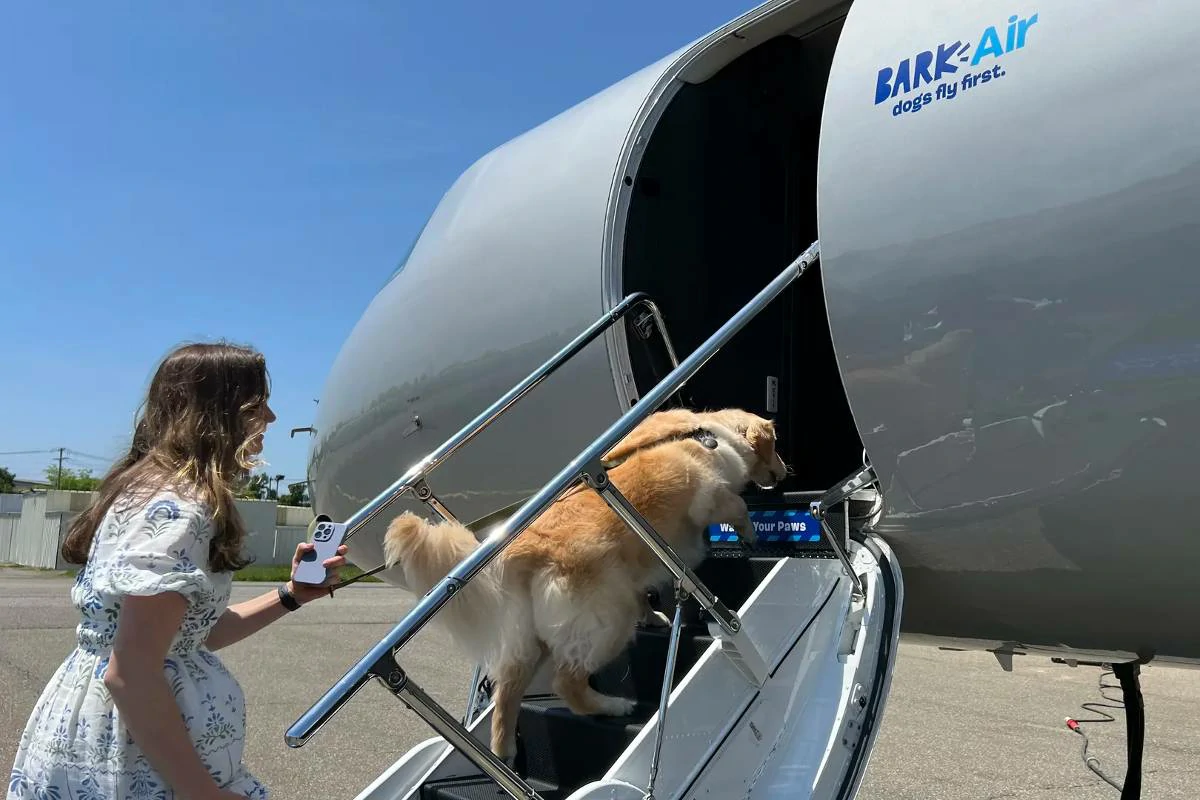
1. Weight limit for dogs on planes
Weight limits for dogs on planes vary depending on whether they are traveling in the cabin or as cargo. For cabin travel, most airlines have a combined weight limit of 20 pounds (9 kg) for the dog and carrier. This is because the carrier must fit under the seat in front of you.
For cargo travel, weight limits are typically much higher, but they can vary depending on the airline and the specific aircraft. Some airlines may have a maximum weight limit of 150 pounds (68 kg) for dogs traveling as cargo.
2. Breed Restrictions
In addition to weight limits, some airlines also have breed restrictions for dogs traveling on their planes. These restrictions are often based on safety concerns and may apply to both cabin and cargo travel.
Commonly restricted breeds include brachycephalic (short-nosed) dogs like Pugs, Bulldogs, and French Bulldogs. These breeds are more susceptible to breathing difficulties and heatstroke, making air travel potentially risky for them.
Other breeds that may be restricted include certain large or working dogs, such as Pit Bulls, Rottweilers, and Doberman Pinschers. These restrictions may be due to concerns about aggression or potential liability issues.
“It’s essential to check the airline’s specific breed restrictions before booking your flight,” advises Dr. Linda Simon, a veterinarian specializing in animal behavior and welfare. “If your dog is a restricted breed, you may need to explore alternative travel options or consult with a veterinarian to discuss potential solutions.”
3. Airline-Specific Regulations
Each airline has its own specific regulations regarding pet travel. These regulations cover various aspects, such as:
- Carrier requirements: Size, material, ventilation, and labeling
- Health certificates: Age, validity period, and required vaccinations
- Check-in procedures: Timing, documentation, and fees
- In-flight care: Feeding, watering, and exercise
- Arrival procedures: Customs clearance and quarantine (for international travel)
It’s crucial to familiarize yourself with the airline’s pet policies well in advance of your trip to ensure compliance and avoid any unexpected delays or issues.
Complete List of Airline Pet Policies
- Alaska Airlines
- American Airlines
- Delta Air Lines
- Hawaiian Airlines
- JetBlue Airways
- Southwest Airlines
- Spirit Airlines
- United Airlines
4. Where to find an airline pet policy
The best place to find an airline’s pet policy is on their official website. Most airlines have a dedicated section on their website that outlines their policies and procedures for traveling with pets.
You can usually find this information under the “Travel Information” or “Customer Service” sections of the website.
Additionally, you can contact the airline’s customer service department to inquire about their pet policies. They can provide you with detailed information and answer any questions you may have.
On the Flight Day
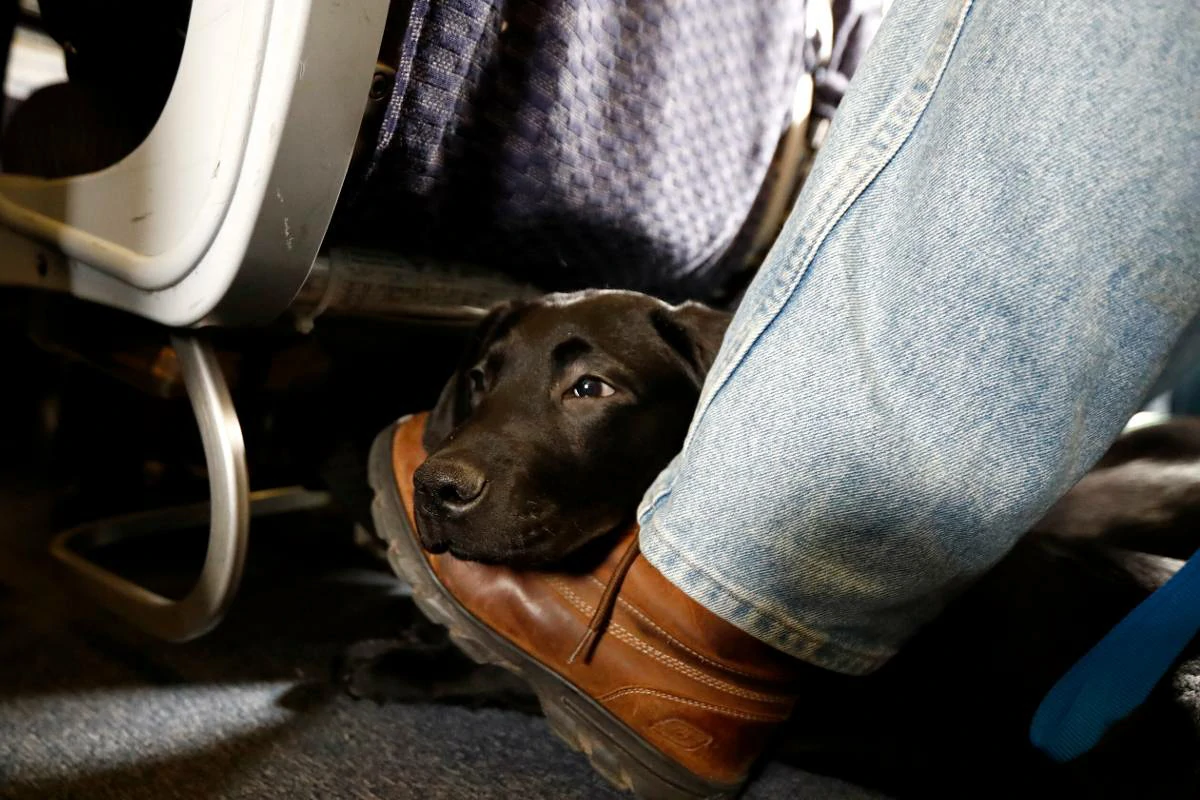
1. Check-In and Security Procedures
On the day of the flight, arrive at the airport early, allowing ample time for check-in and security procedures. If your dog is flying in the cabin, check in at the airline’s ticket counter. If your dog is flying as cargo, check in at the airline’s cargo facility.
“It’s crucial to arrive at the airport well in advance of your flight, especially when traveling with a pet,” advises Lisa Peterson, spokesperson for the American Kennel Club (AKC). “This will give you plenty of time to check in, go through security, and settle your pet before boarding.”
During check-in, you will need to present your dog’s health certificate, vaccination records, and any other required documentation. You may also need to pay a pet fee, which varies depending on the airline and destination.
If your dog is flying in the cabin, you will need to remove them from their carrier during security screening. The carrier will be X-rayed separately. You will then need to carry your dog through the metal detector or walk them through with you if the metal detector is not pet-friendly.
“Be prepared for the security screening process and have your dog on a leash,” suggests Peterson. “Keep a close eye on them and follow the instructions of the TSA agents.”
2. During the Flight
During the flight, prioritize your dog’s comfort and well-being. If your dog is flying in the cabin, ensure their carrier is securely stowed under the seat in front of you. Avoid opening the carrier during the flight, as this could be disruptive and potentially dangerous.
If your dog is flying as cargo, the airline will take care of their needs during the flight. Cargo holds are typically temperature-controlled and pressurized, but it’s still important to ensure your dog is comfortable and has enough space to move around in their crate.
“Consider freezing a bowl of water for your dog before the flight,” recommends Dr. Marty Becker, a veterinarian and author of several books on pet care. “This will provide them with a source of hydration during the journey.”
If you’re concerned about your dog’s anxiety during the flight, talk to your veterinarian about potential calming aids, such as pheromone sprays or anxiety vests.
3. Arrival and Aftercare
Upon arrival at your destination, collect your dog from the appropriate location (either baggage claim for cabin travel or the cargo facility for cargo travel). If your dog is flying as cargo, inspect their crate for any damage and ensure they are in good health.
After a long flight, your dog may be tired, thirsty, and need to relieve themselves. Offer them water and a chance to go to the bathroom as soon as possible.
“It’s important to give your dog time to de-stress and adjust to their new surroundings,” says Dr. Becker. “Offer them a comfortable place to rest, plenty of water, and their favorite toys or treats.”
If you’re traveling internationally, be aware of any quarantine requirements at your destination. These requirements may involve isolating your dog for a certain period or undergoing additional health checks.
Special Considerations

1. Is it safe for dogs to fly? Potential Risks and Precautions
Air travel for dogs, like any form of travel, carries certain risks. However, with careful planning and preparation, these risks can be minimized.
Potential risks include
- Stress and anxiety: The unfamiliar environment, noises, and confinement of air travel can cause stress and anxiety in dogs.
- Health issues: Changes in air pressure and temperature can exacerbate existing health conditions or trigger new ones.
- Injury: Mishandling during loading and unloading or turbulence during the flight can lead to injuries.
- Loss or escape: In rare cases, dogs may become lost or escape during transit.
To mitigate these risks, it’s crucial to take the following precautions
- Consult your veterinarian: Before booking a flight, consult your veterinarian to assess your dog’s fitness for air travel and discuss any necessary preparations, such as vaccinations and health certificates.
- Acclimate your dog to the carrier: Gradually introduce your dog to their carrier and make it a positive and comfortable space.
- Choose a reputable airline: Research airlines with a good track record of pet safety and choose one that prioritizes the well-being of animal passengers. The U.S. Department of Transportation maintains an Air Travel Consumer Report where you can find information about each airline’s animal incident history.
- Prepare for potential delays: Pack extra food, water, and any necessary medications in case of unexpected delays.
- Label the carrier clearly: Ensure your dog’s carrier is clearly labeled with your contact information and your dog’s identification details.
“By taking these precautions and working closely with your veterinarian, you can minimize the risks associated with air travel and ensure a safe and comfortable journey for your dog,” says Dr. Ann Hohenhaus, a veterinarian at the Animal Medical Center in New York City.
2. Emotional Support Animals (ESAs) on Planes
Emotional Support Animals (ESAs) are animals that provide comfort and support to individuals with emotional or psychological disabilities. While ESAs are not required to have specific training like service animals, they must be prescribed by a licensed mental health professional.
In the past, ESAs were allowed to fly in the cabin with their owners free of charge. However, recent changes in airline policies have made it more difficult for ESAs to travel on planes.
The U.S. Department of Transportation (DOT) revised its Air Carrier Access Act regulations in 2020, clarifying the definition of a service animal and limiting the types of animals that qualify as ESAs.
Under the new rules, airlines are only required to accommodate dogs that are individually trained to perform tasks for individuals with disabilities.
You can review the DOT’s Final Rule on Traveling by Air with Service Animals for further clarification.
“While the new DOT regulations may seem restrictive, they are aimed at ensuring the safety and well-being of all passengers, including those with disabilities,” explains Rebecca Cross, a disability rights advocate and attorney. “Legitimate service animals are essential for many individuals, and it’s important to protect their rights and access to air travel.”
If you plan to travel with an ESA, it’s crucial to check the airline’s specific policy and requirements. You may need to provide documentation from your mental health professional and ensure your animal meets the airline’s behavioral and health standards.
3. Traveling with Senior or Anxious Dogs
Senior dogs and dogs with anxiety may require special considerations when traveling by air. Older dogs may have mobility issues or underlying health conditions that make air travel more challenging. Anxious dogs may experience heightened stress and anxiety in unfamiliar environments.
If you’re traveling with a senior or anxious dog, consider the following tips
Consult your veterinarian: Discuss your travel plans with your veterinarian to assess your dog’s fitness for air travel and address any concerns about their health or anxiety.
Choose a direct flight: Opt for a direct flight to minimize travel time and reduce stress for your dog.
Consider a calming aid: Talk to your veterinarian about potential calming aids, such as pheromone sprays, anxiety vests, or medication, to help your dog relax during the flight. The American Society for the Prevention of Cruelty to Animals (ASPCA) provides additional information on calming aids for pets.
Book a pet-friendly hotel: Choose a hotel that welcomes pets and offers amenities like dog beds, bowls, and outdoor areas for exercise.
Create a familiar environment: Bring familiar items from home, such as your dog’s bed, blanket, and toys, to create a sense of security and comfort.
Be patient and understanding: Give your dog plenty of time to adjust to their new surroundings and be patient with their anxieties.
“By taking these extra steps, you can make air travel a more positive experience for your senior or anxious dog,” says Dr. Bonnie Beaver, a veterinarian specializing in animal behavior and author of several books on pet care. “Remember, a little extra care and attention can go a long way in ensuring your furry companion’s comfort and well-being.”
Tips for a Smooth Journey
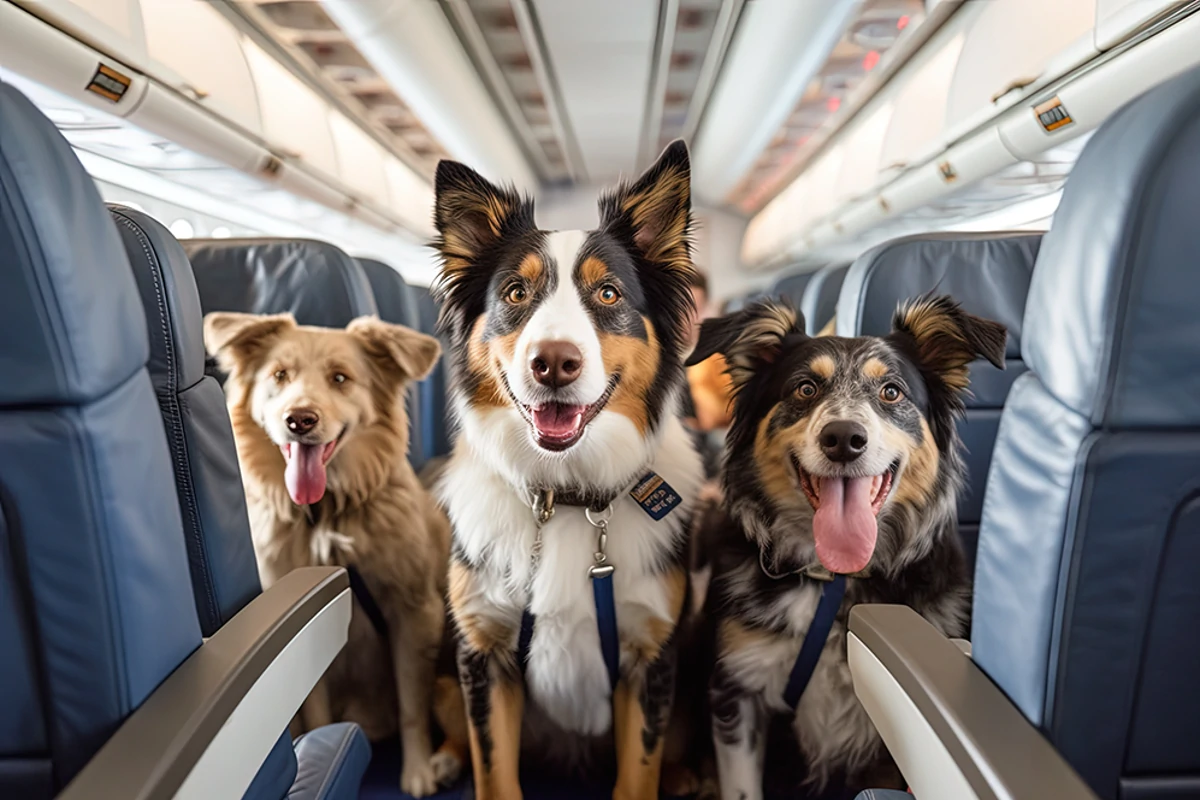
1. Tips for traveling with a dog: Reducing Stress and Ensuring Comfort
Traveling can be stressful for dogs, but with some careful planning and preparation, you can make the experience as smooth and comfortable as possible for your furry friend. Here are some expert tips to ensure a safe and enjoyable journey:
Visit your veterinarian: Before embarking on any trip, schedule a checkup with your veterinarian. Ensure your dog is up-to-date on vaccinations and has a clean bill of health for travel. If your dog experiences anxiety, discuss potential calming aids or medications with your veterinarian.
Acclimate your dog to the carrier: Make the carrier a positive and familiar space for your dog by introducing it gradually. Place treats, toys, and bedding inside and encourage your dog to spend time in it.
Exercise before the flight: A tired dog is a calmer dog. Take your dog for a long walk or play session before heading to the airport to help them relax during the flight.
Choose a direct flight, if possible: Direct flights minimize travel time and reduce the stress of layovers for your dog.
Pack familiar items: Bring your dog’s favorite blanket, toy, and treats to create a sense of familiarity and comfort.
Label the carrier clearly: Ensure the carrier is clearly labeled with your dog’s name, your contact information, and flight details.
Follow airline guidelines: Adhere to the airline’s pet policies and procedures to avoid any complications or delays.
Stay calm and patient: Your dog will pick up on your emotions, so remain calm and reassuring throughout the journey.
“Traveling with your dog can be a wonderful experience,” says Dr. Ernie Ward, a veterinarian and founder of the Association for Pet Obesity Prevention. “By following these tips and prioritizing your dog’s well-being, you can ensure a safe and enjoyable journey for both of you.”
2. Essential Packing List
Packing for your dog’s trip is just as important as packing for yourself. Here’s an essential packing list to ensure you have everything your furry friend needs:
Food and water: Pack enough food and water for the duration of the trip, plus some extra in case of delays. Bring collapsible bowls for easy feeding and watering on the go.
Medication: If your dog takes any medications, pack enough for the trip, plus a few extra days’ supply.
Leash and harness: A sturdy leash and harness are essential for walks and bathroom breaks.
Collar with ID tags: Make sure your dog’s collar has up-to-date identification tags with your contact information. Consider a microchip as an additional form of identification.
Crate or carrier: Choose a crate or carrier that is appropriate for your dog’s size and complies with airline regulations.
Bedding: Pack a familiar blanket or bed to provide comfort and security for your dog.
Toys and treats: Bring your dog’s favorite toys and treats to keep them entertained and occupied during the journey.
Waste bags: Be a responsible pet owner and clean up after your dog.
First-aid kit: A basic first-aid kit can be helpful in case of minor injuries or ailments.
Health certificate and vaccination records: These documents are often required by airlines and may be needed at your destination.
“Packing all the essentials for your dog ensures their comfort and safety during travel,” says Dr. Ward. “By being prepared, you can focus on enjoying your trip with your furry companion.”
FAQs
Can I give my dog a sedative before the flight?
It’s not generally recommended to sedate your dog before a flight unless specifically advised by your veterinarian. Sedation can interfere with your dog’s natural ability to regulate their body temperature and balance, potentially posing risks during air travel. Instead, focus on acclimating your dog to the carrier, providing comfort items, and creating a calming environment.
What if my dog needs to go to the bathroom during the flight?
If your dog is flying in the cabin, you can take them to a designated pet relief area in the airport before or after the flight. Some airports even have indoor pet relief areas. If your dog is flying as cargo, the airline will typically provide bathroom breaks during layovers.
How much does it cost to fly with a dog?
The cost of flying with a dog varies depending on the airline, destination, and travel method (cabin or cargo). In-cabin pet fees typically range from $50 to $250 each way, while cargo fees can range from several hundred to several thousand dollars, depending on the size and weight of your dog.
Are there any breed restrictions for dogs flying on planes?
Yes, some airlines have breed restrictions for dogs flying on planes. Commonly restricted breeds include brachycephalic (short-nosed) dogs and certain large or working dogs. It’s essential to check the airline’s specific breed restrictions before booking your flight.
What should I do if my dog gets lost or injured during the flight?
If your dog gets lost or injured during the flight, contact the airline immediately. They will initiate a search for your dog if they are lost and provide assistance if they are injured. It’s also a good idea to have pet insurance that covers travel-related incidents.
The Bottom Line
Is Flying with Your Dog Right for You?
The decision of whether or not to fly with your dog is a personal one that requires careful consideration. While traveling with your furry companion can be rewarding, it also comes with challenges and responsibilities.
Before making a decision, weigh the pros and cons of flying with your dog. Consider your dog’s breed, size, age, health, and temperament. Assess your own comfort level with the potential risks and logistical challenges of air travel with a pet.
If you decide to fly with your dog, meticulous planning and preparation are crucial. Research airline policies, choose the appropriate travel method (cabin or cargo), and ensure your dog is healthy and well-prepared for the journey.

